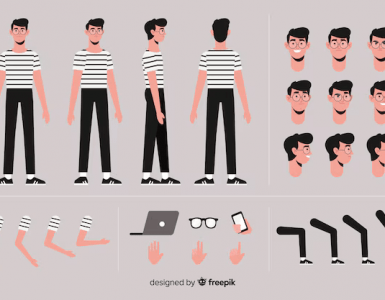Whether you’re a freelancer or someone hiring one, contracts are really important.
It’s a guarantee on both sides that you’ll hold up your end of the bargain, and neither of you will end up feeling scammed! Writing one can be tricky though.
There’s lots of information to remember to include. If you leave something important out it could end up costing you.

So to help you out we’ve created the ultimate guide to constructing a contract. We’ve even made things really simple for you, by whipping up a fantastic freebie: your very own template to use as you please in all your freelance projects.
Contracts offer protection for both the freelancer and the client. Don’t go into business without first drawing one up. Even the most straightforward of projects can end up having complications down the line.
Be sure to put the details of your freelance arrangement in writing. I can’t count the number of times an entrepreneur contacted me and sought my help after a relationship with a freelancer deteriorated. The first question I always ask is to see a copy of the contract – Jaia Thomas ‘3 Legal Precautions to Hiring Freelancers’
“Upon Sellers’s receipt of full payment from the Buyer, the Work agreed as part of the Freelancer Services, including without limitation all Intellectual Property Rights in the Work, will be the sole and exclusive property of Buyer, and Buyer will be deemed to be the author thereof.
If the Seller has any Intellectual Property Rights to the Work that are not owned by Buyer upon Seller’s receipt of payment from Buyer, Twine hereby automatically irrevocably assigns to Buyer all right, title, and interest worldwide in and to such Intellectual Property Rights. If payment is made only for partial delivery of the Work, the assignment described herein applies only to the portion of Work delivered.”
Firstly, what is a contract?
It’s literally a piece of paper that states in basic terms, what work will be done, who will do it, when it needs to be done by and how much will be paid for the work. This then needs to be signed by all parties involved (usually the freelancer and client). To make things simpler, you could even use an online PDF signing tool – add your signature and then just request theirs. Easy!
Lots of people assume that contracts are difficult documents full of legal jargon, but we’re here to bust that myth. Read on to discover all you need to know about drawing up a basic contract between freelancer and client:
1. Give it a title
Your contract needs a title that explains what it is. For example Freelance Web Design Contract or Freelance Illustration Contract.
2. Who’s involved?
Next, state who’s involved in the contract, and the name that you’ll refer to them by throughout the rest of the document:
This Web Design contract is made and entered into by and between Ellen West (“Freelancer”) and James Parsons (“Client”).
If your client is a company, use their full business name here:
This Web Design contract is made and entered into by and between Ellen West (“Freelancer”) and The Big Car Company LLC (“Client”).
Follow this with a statement that says both people agree to the terms of the contract, like:
Ellen West (“Freelancer”) and The Big Car Company LLC (“Client”) agree as follows …
3. What’s the project?
Next, give a description of what the project is. Describe the work that the freelancer needs to carry out. The more specific you can be here the better – give as much detail as possible so that the freelancer knows exactly what they need to do.
“The freelancer needs to make a website for the client” is way too broad. Is domain and hosting included in this? Does the website need to work on all devices? What language will it be programmed in? How many pages will there be? Does the freelancer need to source images?
If you don’t provide enough detail the project will spiral out of control. Your freelancer could, quite legitimately, refuse to complete any additional requests that aren’t written down in the contract, so make sure you pack in all the detail you can.
If the project is small, a short description will work fine:
The freelancer needs to change the colour of the client’s logo from red to blue.
It’s also fine to use general terms if you’re sure there’ll be no dispute further down the line. For example:
The freelancer will undertake any design tasks as necessary.
4. Who will be paid and how much?
Next, it’s time to talk money. Write down who will be paid, how much, how they will be paid, and when.
Per hour:
The Client will pay the Freelancer $X per hour due on or before the first Friday following the end of any week in which the Freelancer completes services for Client.
Flat project fee:
The Client will pay the Freelancer a flat fee of $X due on or before the first Friday following the end of any week in which the Freelancer completes services for Client.
If applicable, include milestones:
The Client will pay the Freelancer a flat fee of $X as total compensation for the project described. Payment will be made as follows: $X due before commencement of work and $X due on or before the first Friday following the end of any week in which the Freelancer completes services for Client.
If the client or freelancer has any specific payment terms that need to be adhered to, it’s a good idea to enter them in this section. For example:
The Client will pay the Freelancer via PayPal.
5. How will the work be carried out?
Where will the freelancer be carrying out the work and how? This is important for tax purposes so that your freelancer can’t be confused as an employee of the company:
It’s understood that the Freelancer is an independent contractor and not an employee of the company/Client. As such the freelancer is not entitled to any benefits that the company offers.
6. Project schedule
Next, outline a project schedule. If possible, you should describe the steps needed for the freelancer to complete the project:
The Freelancer shall commence the provision of the Services on [insert date here].
The Freelancer agrees to provide first drafts by [Date]. After approval of the draft from the Client, the Freelancer agrees to provide an updated draft by [Date].
7. What happens if it goes wrong?
You probably won’t need it, but it’s always good to include grounds for termination of the contract. Examples are missed deadlines or missed payments. This is called a breach of contract:
In the event of a breach of the contract, either party has the right to terminate this contract within 14 days notice of the breach by the non-breaching party. The Client may also terminate the contract immediately in its sole discretion in the event that the Client does not adhere to the agreed deadline.
You should also include how the contract could be terminated by either party, should they wish to do so:
Either Party may terminate this Agreement upon notice in writing if:
- the other is in breach of any material obligation contained in this Agreement, which is not rectified (if it is is able to be rectified) within 30 days of written notice from the other Party to do so.
or
-
a voluntary arrangement is approved, for example a bankruptcy or an administration order is made or a receiver or administrative receiver is appointed over any of the other Party’s assets or an undertaking or a resolution or petition to wind up the other Party is passed or presented (other than for the purposes of amalgamation or reconstruction) or any analogous procedure in the country of incorporation of either party or if any circumstances arise which entitle the Court or a creditor to appoint a receiver, administrative receiver or administrator or to present a winding-up petition or make a winding-up order in respect of the other Party.
8. Who owns the work?
It’s really important to spell out who will own the finished project once it’s completed. Otherwise, things could get hairy if you find the freelancer using the project, or parts of the project elsewhere because they’re under the impression that the rights belong to them.
All documents produced by the Freelancer, including but not limited to code, assets, and copy in the course of his work for the Client, shall be the property of the Client and the Freelancer shall retain no ownership, interest or rights therein.
9. For your eyes only
Do you need a confidentiality agreement or NDA (non-disclosure agreement)? These are usually required when the project contains some sort of confidential information. If so, this will need to be written into the contract. Some example text for this scenario could be as follows:
Contractor acknowledges that he/she may be furnished with information relating to Client’s products, vendor lists, creative works, business or marketing strategies, pending projects, and other confidential information. Contractor agrees not to disclose this confidential information unless required by law or court order. This duty to maintain confidentiality shall continue throughout the life of the contract.
10. Legal stuff
Set out which law will govern the contract. Usually, it’s the client’s governing laws that preside over the contract, but you could use the law where the client lives:
This Agreement shall be governed by the laws of the jurisdiction in which the Client is located (or if the Client is based in more than one country, the country in which its headquarters are located) (the “Territory”) and the parties agree to submit disputes arising out of or in connection with this Agreement to the non-exclusive of the courts in the Territory.
11. Severability
You should include a severability clause in your contract. This means that, if any of the terms of your contract are found to be faulty by a court, all other terms in the contract will still stand and be enforceable.
If any provision of this Agreement is held by a court of law to be illegal, invalid or unenforceable, (a) that provision shall be deemed amended to achieve as nearly as possible the same economic effect as the original provision, and (b) the legality, validity and enforceability of the remaining provisions of this Agreement shall not be affected or impaired thereby.
12. Misc
If needed, add a misc section for any additional information you might need. For example, you can add in this section that the contract can’t be changed without prior written consent from both parties. You can also use this section to include any changes to clauses that were made after the contract was signed or any new clauses that were added after this time.
13. Date it
Add the date to the contract – this should be the date that both parties will sign the contract. If you’re unsure of the date, leave a blank line so you can fill it in later.
Agreed to on 23/12/2016
Or
Agreed to on _____________
14. Sign it
Next, make a space for both your signatures. Something like this will do fine, just ensure the area you leave clear is big enough to fit either a handwritten or electronic signature in it:
Freelancer: Client:
___________________ ___________________
Ellen West James Parsons
15. Format and check
Next, if you haven’t done so already, make sure each section of your contract has a simple heading and is numbered. This is so you can refer to each clause of the contract quickly when needed. For example:
- Engagement of services:
- Compensation:
- Freelancer relationship:
- Project schedule
- Etc.
The last step is to check and double-check everything. Make sure there are no typos or missing information as this could render your contract invalid.
16. You’re done!
That’s it! Take a look at our sample contract for more ideas on how to layout a contract document. Or better still, you can download and use a free contract template for yourself.
We’ve included examples in each section of the type of information you might want to include. But it’s up to you to check and delete/add information where appropriate. The examples we’ve included won’t be suitable for everyone.
Ready to hire? Our marketplace of over 410,000 freelancers has the skills and expertise needed to skyrocket your business to the next level. From marketers to designers, copywriters to SEO experts – browse the talented bunch here!








